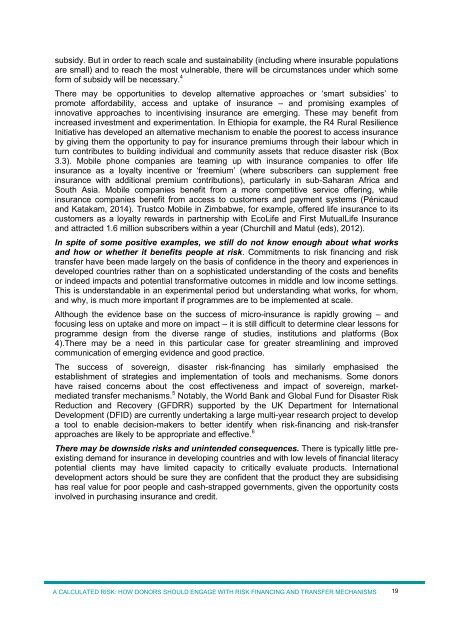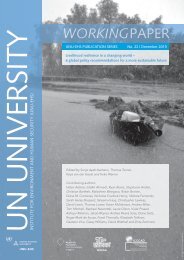k5q82a3
k5q82a3
k5q82a3
You also want an ePaper? Increase the reach of your titles
YUMPU automatically turns print PDFs into web optimized ePapers that Google loves.
subsidy. But in order to reach scale and sustainability (including where insurable populations<br />
are small) and to reach the most vulnerable, there will be circumstances under which some<br />
form of subsidy will be necessary. 4<br />
There may be opportunities to develop alternative approaches or ‘smart subsidies’ to<br />
promote affordability, access and uptake of insurance – and promising examples of<br />
innovative approaches to incentivising insurance are emerging. These may benefit from<br />
increased investment and experimentation. In Ethiopia for example, the R4 Rural Resilience<br />
Initiative has developed an alternative mechanism to enable the poorest to access insurance<br />
by giving them the opportunity to pay for insurance premiums through their labour which in<br />
turn contributes to building individual and community assets that reduce disaster risk (Box<br />
3.3). Mobile phone companies are teaming up with insurance companies to offer life<br />
insurance as a loyalty incentive or ‘freemium’ (where subscribers can supplement free<br />
insurance with additional premium contributions), particularly in sub-Saharan Africa and<br />
South Asia. Mobile companies benefit from a more competitive service offering, while<br />
insurance companies benefit from access to customers and payment systems (Pénicaud<br />
and Katakam, 2014). Trustco Mobile in Zimbabwe, for example, offered life insurance to its<br />
customers as a loyalty rewards in partnership with EcoLife and First MutualLife Insurance<br />
and attracted 1.6 million subscribers within a year (Churchill and Matul (eds), 2012).<br />
In spite of some positive examples, we still do not know enough about what works<br />
and how or whether it benefits people at risk. Commitments to risk financing and risk<br />
transfer have been made largely on the basis of confidence in the theory and experiences in<br />
developed countries rather than on a sophisticated understanding of the costs and benefits<br />
or indeed impacts and potential transformative outcomes in middle and low income settings.<br />
This is understandable in an experimental period but understanding what works, for whom,<br />
and why, is much more important if programmes are to be implemented at scale.<br />
Although the evidence base on the success of micro-insurance is rapidly growing – and<br />
focusing less on uptake and more on impact – it is still difficult to determine clear lessons for<br />
programme design from the diverse range of studies, institutions and platforms (Box<br />
4).There may be a need in this particular case for greater streamlining and improved<br />
communication of emerging evidence and good practice.<br />
The success of sovereign, disaster risk-financing has similarly emphasised the<br />
establishment of strategies and implementation of tools and mechanisms. Some donors<br />
have raised concerns about the cost effectiveness and impact of sovereign, marketmediated<br />
transfer mechanisms. 5 Notably, the World Bank and Global Fund for Disaster Risk<br />
Reduction and Recovery (GFDRR) supported by the UK Department for International<br />
Development (DFID) are currently undertaking a large multi-year research project to develop<br />
a tool to enable decision-makers to better identify when risk-financing and risk-transfer<br />
approaches are likely to be appropriate and effective. 6<br />
There may be downside risks and unintended consequences. There is typically little preexisting<br />
demand for insurance in developing countries and with low levels of financial literacy<br />
potential clients may have limited capacity to critically evaluate products. International<br />
development actors should be sure they are confident that the product they are subsidising<br />
has real value for poor people and cash-strapped governments, given the opportunity costs<br />
involved in purchasing insurance and credit.<br />
A CALCULATED RISK: HOW DONORS SHOULD ENGAGE WITH RISK FINANCING AND TRANSFER MECHANISMS<br />
19



